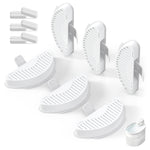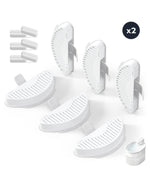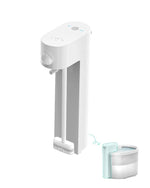For pet owners, the joy of having a furry companion often comes with the challenge of managing pet dander. This microscopic allergen can trigger allergies, asthma, and other respiratory issues, making it a significant concern. Many turn to air purifiers as a solution, but the question remains: do air purifiers work for pet dander? This article dives deep into the science behind air purifiers, their effectiveness against pet dander, and how to choose the right one for your home.
Understanding Pet Dander
Pet dander consists of tiny, even microscopic, flecks of skin shed by cats, dogs, rodents, birds, and other animals with fur or feathers. These particles can linger in the air and settle on surfaces, making them difficult to eliminate. For individuals with allergies or asthma, pet dander can be a major trigger, leading to sneezing, coughing, and other discomforts.
How Air Purifiers Work
Air purifiers are designed to improve indoor air quality by removing contaminants from the air. They typically use filters, such as HEPA (High-Efficiency Particulate Air) filters, to capture particles like dust, pollen, mold spores, and pet dander. Some air purifiers also incorporate additional technologies, such as activated carbon filters or UV light, to neutralize odors and kill bacteria or viruses.
Do Air Purifiers Effectively Remove Pet Dander?
The effectiveness of air purifiers in removing pet dander largely depends on the type of filter and the purifier's overall design. HEPA filters are particularly effective at capturing particles as small as 0.3 microns, which includes most pet dander. Studies have shown that air purifiers with HEPA filters can significantly reduce airborne pet dander, providing relief for allergy sufferers.
Factors to Consider When Choosing an Air Purifier
When selecting an air purifier to combat pet dander, consider the following factors:
- Filter Type: Look for a purifier with a true HEPA filter for optimal dander removal.
- Room Size: Ensure the purifier is suitable for the size of the room where it will be used.
- Air Change Rate: Higher air change rates mean the purifier can clean the air more frequently.
- Additional Features: Features like activated carbon filters can help reduce pet odors.
Tips for Maximizing Air Purifier Effectiveness
To get the most out of your air purifier, follow these tips:
- Place the purifier in a central location where it can circulate air effectively.
- Keep doors and windows closed to prevent outdoor allergens from entering.
- Regularly clean and replace filters as recommended by the manufacturer.
- Combine the use of an air purifier with regular cleaning to reduce dander on surfaces.
Common Misconceptions About Air Purifiers and Pet Dander
There are several misconceptions about air purifiers and their ability to handle pet dander. One common myth is that all air purifiers are equally effective. In reality, the type of filter and the purifier's specifications play a crucial role in its performance. Another misconception is that air purifiers can completely eliminate pet dander. While they can significantly reduce airborne dander, they are not a standalone solution and should be used in conjunction with other cleaning practices.
The Role of Air Purifiers in Allergy Management
For individuals with pet allergies, air purifiers can be a valuable tool in managing symptoms. By reducing the amount of pet dander in the air, purifiers can help alleviate sneezing, itchy eyes, and other allergic reactions. However, it's important to note that air purifiers are not a cure for allergies and should be part of a comprehensive allergy management plan.
Alternative Solutions for Reducing Pet Dander
While air purifiers are effective, there are other steps you can take to reduce pet dander in your home:
- Groom your pet regularly to minimize shedding.
- Use hypoallergenic bedding and furniture covers.
- Vacuum frequently with a vacuum cleaner equipped with a HEPA filter.
- Wash your pet's bedding and toys regularly.
Expert Opinions on Air Purifiers and Pet Dander
Experts generally agree that air purifiers can be beneficial for reducing pet dander, especially for those with allergies or asthma. However, they emphasize the importance of choosing a high-quality purifier with a HEPA filter and using it consistently. Additionally, experts recommend combining air purifiers with other strategies, such as regular cleaning and grooming, to achieve the best results.
Real-Life Experiences with Air Purifiers
Many pet owners have shared positive experiences with air purifiers, noting improvements in air quality and a reduction in allergy symptoms. However, some have found that air purifiers alone are not enough to completely eliminate pet dander. These real-life experiences highlight the importance of using air purifiers as part of a broader approach to managing pet dander.
Scientific Studies on Air Purifiers and Pet Dander
Several scientific studies have examined the effectiveness of air purifiers in reducing pet dander. One study found that air purifiers with HEPA filters significantly reduced airborne pet dander in homes with cats. Another study concluded that air purifiers can be an effective tool for managing pet allergies, particularly when used in combination with other strategies.
Potential Drawbacks of Air Purifiers
While air purifiers offer many benefits, there are some potential drawbacks to consider. Some purifiers can be noisy, which may be a concern for light sleepers. Additionally, the cost of replacement filters can add up over time. It's also important to note that air purifiers are not a substitute for regular cleaning and grooming practices.
How to Maintain Your Air Purifier
Proper maintenance is essential to keep your air purifier functioning effectively. Follow these maintenance tips:
- Check and replace filters according to the manufacturer's recommendations.
- Clean the exterior of the purifier regularly to remove dust and debris.
- Monitor the purifier's performance and address any issues promptly.
Final Thoughts on Air Purifiers and Pet Dander
Air purifiers can be a valuable tool for reducing pet dander and improving indoor air quality, especially for those with allergies or asthma. By choosing a high-quality purifier with a HEPA filter and using it consistently, you can significantly reduce airborne pet dander in your home. However, it's important to remember that air purifiers are not a standalone solution and should be used in conjunction with other cleaning and grooming practices. With the right approach, you can create a healthier living environment for both you and your pet.
If you're struggling with pet dander and its effects on your health, investing in an air purifier could be a game-changer. Explore your options, consider the factors discussed in this article, and take the first step toward breathing easier in your home.












